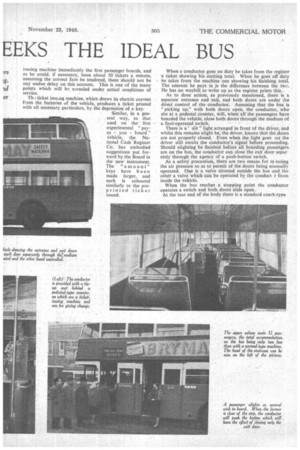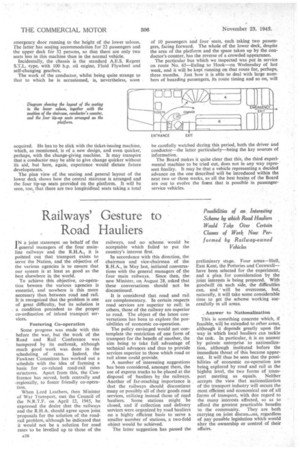LONDON TRANSPORT EEKS THE IDEAL BUS
Page 26

Page 27

Page 28

If you've noticed an error in this article please click here to report it so we can fix it.
Separate Entrance and Exit for to Speed Up Boarding and Improved Ticket issuing Mc Electro-pneumatic Door Operatio Features' of Experimental
THE standard type of bus as we know it to-day, with its rear entrance and exit, and its conductor who has to visit every passenger to collect fares, may be subject to criticism from several aspects, but the evolving of a new type, having fewer imperfections; is not easy of solution.
London Transport is fully alive to all the problems involved, and experimental machines have been tested out with a view to getting down to something in the nature of a basic type. The most recent developments are based on the pay-as-you-board principle, the conductor being seated behind a counter, from where he issues the tickets and gives change, if necessary.
It is along these lines that the Board hopes to solve two important matters. One concerns the conductor and the other the passengers. It must,be admitted that it is particularly tiring for a conductor to have to ascend and descend the stairs hundreds of times a day, and the pay-as-you-board type of vehicle at once solves this problem.
• Step accidents to passengers, however, are a somewhat different matter, and not so straightforward of solution. The latest attempt to meet the two foregoing requirements and, at the same time, to put on the road a vehicle that can maintain a normal time-table, was shown to the public for the first time last week.
In many respects it follows the design of the previous pay-as-you-board machines, but in this latest vehicle there is a separate entrance and exit, to give a uniflow movement to boarding and alighting passengers. As will be seen from the accompanying illustrations, the conventional rear platform has been abandoned. Instead, there are two electro-pneumatically operated sliding doors arranged forward on the near side, of course.
Behind the entrance door there is platformn space sufficient to accommodate 12 people, so that this number can board the bus without inconvenience being caused by those passengers wishing to alight. The query may be raised as to what happens should, say, 20 people wish to board the vehicle. Would the bus have to remain standing while the platform space became clear for the extra eight people?
Surprising as it may seem, it is not by any means general that 20 people do wish to get on the same bus, en route, at the same time, and, 'even so, there are numerous occasions when there are not 20 seats vacant. In any case, the conductor starts to issue tickets by the aid of a National ticket
issuing machine immediately the first passenger boards, and as he could, if necessary, issue about 50 tickets a minute, assuming the correct fare be tendered, there should not be any undue delay on this account. This is one of the many points which will be revealed under actual conditions of service.
Th : ticket issuing machine, which draws its electric current from the batteries of the vehicle, produces a ticket printed with all necessary particulars, by the depression of a key.
Similar, in a general way, to that used on the first experimental "payas you board" vehicle, the National Cash Register Co. has embodied suggestions put forward by the Board in the new instrument. The "amount" keys have been made larger, and each is coloured similarly to the preprinted ticket issued. When a conductor goes on duty he takes from the register a ticket showing his starting total. When he goes off duty he takes from the machine one showing his finishing total. The amount he pays in js the difference between the twc. He has no waybill to write up as the register prints this.
As to door action, as previously mentioned, there is a separate entrance and exit, and both doors are under the direct control of the conductor. Assuming that the bus is "picking up," with both doors open, the conductor, who sits at a pedestal counter, will, when all the passengers have boarded the vehicle, close both doors through the medium of a foot-operated switch.
There is a slit" light arranged in front of the driver, and whilst this remains alight he, the driver, knows that the doors are not properly closed. Even when the light goes tut the driver still awaits the conductor's signal before proceeding. Should alighting be finished before all boarding passengers are on the bus, the conductor can close the exit door separately through the agency of a push-button switch.
As a safety precaution, there are two means for re easing the air pressure so as to permit of the doors being manually operated. One is a valve situated outside the bus and the other a valve which can be operated by the conduct r from inside the vehicle.
When the bus reaches a stopping point the conductor operates a switch and both doors slide open. At the rear end of the body there is a standard coach-type emergency door running to the height of the lower saloon. The latter has seating accommodation for 22 passengers and the upper deck for 32 persons, so that there are only two seats less in this machine than in the normal vehicle.
Incidentally, the chassis is the standard A.E.S. Regent S.T,L. 'type, with 100 h.p. oil engine, Fluid Flywheel and self-changing gearbox.
The work of the conductor, whilst being quite strange to that to which he is accustomed, is, nevertheless, soon acquired. He has to be slick with the ticket-issuing machine, which, as mentioned, is of a new design, and even quicker, perhaps, with the change-giving machine. It may transpire that a conductor may be able to give change quicker without ifs aid, but here, again, experience would dictate future developments.
The plan view of the seating and general layout of the lower deck shows how the central staircase is arranged and the four tip-up seats provided on the platform. It will be seen, too, that there are two longittidinal seats taking a total
of 10 passengers and four seats, each taking two passengers, facing forward. The whole of the lower deck, despite the area of the platform and the space taken up by the conductor's counter, has the reverse of a crowded appearance.
The particular bus which we inspected was put in service on route No. 65—Ealing to Hook—on Wednesday of last week, and it will be kept running on that route for, perhaps, three months. Just how it is able to deal with large numbers of boarding passengers, its route timing and so on, will be carefully watched during this period, both the driver and conductor—the latter particularly—being the key sources of information.
The Board makes it quite clear that this, the third experimental machine to be tried out, does not in any way represent finality. It may be that a vehicle representing a decided advance on the one described will be introduced within the next two or three weeks, as all the best brains of the Board are out to evolve the finest that is possible in passengerservice vehicles.




















































